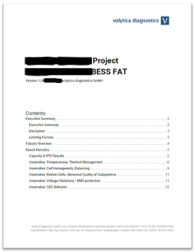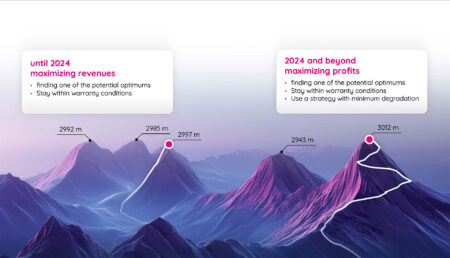
100 Percent Test Depth for Battery Commissioning
Automated in-depth testing of battery modules during the commissioning of stationary energy storage systems
Stationary battery storage systems are complex systems. They consist of cells, modules, racks, and peripherals from various manufacturers. Hence, careful BESS commissioning is essential to ensure reliable and efficient operation. Factory Acceptance Tests (FAT), i.e. acceptance tests after the battery storage system has been manufactured, and Site Acceptance Tests (SAT), i.e. acceptance tests after installation on site, play a central role.
Prevention instead of repair
A recent study by the Electric Power Research Institute (EPRI) shows that almost 50% of serious failures of battery energy storage systems (BESS) occur in the first year after commissioning. These incidents cause considerable economic and safety-related damage. Early problem detection and rectification during SAT and FAT are significantly more cost-efficient than later repairs.
There are manufacturer-independent companies that offer SAT and FAT. However, as BESS increases, the depth of testing of the most important element, the battery, is often superficial. While the testing of mechanical components and the quality of the installation can be carried out by visual inspection, the quality assurance of the battery presents a challenge. Today, only the performance of complete containers – some of which consist of millions of cells – is usually tested as a single unit. However, the subsequent problems occur at the module or cell level.
Data-based analysis and automated tests

Conventional approaches, such as random visual inspections, are insufficient to identify internal problems and mutual interactions in these complex electrochemical systems. In contrast, data-based approaches, such as those used by volytica diagnostics, enable a sufficient depth of analysis with short evaluation times of less than 24 hours.
Sophisticated diagnostic tools automatically evaluate the battery data obtained during electrical load tests and determine key performance parameters such as capacity, resistance and efficiency. Subtle signs of thermal inhomogeneities, charge imbalances, quality problems or early signs of cell degradation are detected and can be specifically addressed.
Examples from the field
Anomalies detected by volytica during SAT and FAT of BESS concern performance, safety, and lifetime.
A recurring case of lifetime relevant anomalies are early signs of cell degradation: increased resistance, reduced capacity, and reduced efficiency of cells or modules. As part of a SAT, several modules were identified that had a significantly lower capacity in comparison and could be specifically claimed.
Furthermore, imbalanced cells have already been identified several times during FAT and SAT. If battery cells within a module have different states of charge (SOC), the usable capacity of the module decreases. With the knowledge gained, the proper functioning of the balancing system can be checked on-site. Targeted charge equalization can make the original capacity of the module available again.
Continuous monitoring for ongoing reliability

While FAT and SAT help ensure initial uptime, continuous monitoring of BESS is critical to maintaining long-term performance.
Advanced monitoring systems can detect impending problems so that timely action can be taken. They can make recommendations to extend the life of components and optimize their use.
By continuously collecting and analyzing battery data, volytica provides BESS operators and owners with critical insight into battery health and performance, supporting preventive maintenance and strategic planning.
The additional cost of such analysis is typically less than 0.5% of the investment and far less than the potential savings.
Conclusion
The importance of SAT and FAT for the use of stationary BESS will continue to increase. These tests are critical for identifying and fixing problems before the storage systems are put into operation to ensure economical and efficient problem-solving and to set the stage for smooth, reliable, and profitable operations.
BESS owners, operators, and investors should recognize the importance of FAT and SAT in securing their assets and insist on it being carried out – regardless of the manufacturer’s warranty promises.
The use of data-driven analysis and automated quality assessment significantly improves conventional inspections and sampling procedures. This ensures that investments are long-lasting, efficient, and sustainable, making an important contribution to a resilient and reliable energy infrastructure.

Claudius Jehle is the founder and managing director of volytica diagnostics GmbH, an independent software provider of battery monitoring software based in Dresden.
He studied mechanical engineering and system identification at the Technical Universities of Munich and Delft (Netherlands) until 2012 and then headed the “Energy Storage Diagnostics and Telematics” research group at the Fraunhofer Institute for Transportation and Infrastructure Systems IVI in Dresden from 2013 until the spin-off in 2019.


